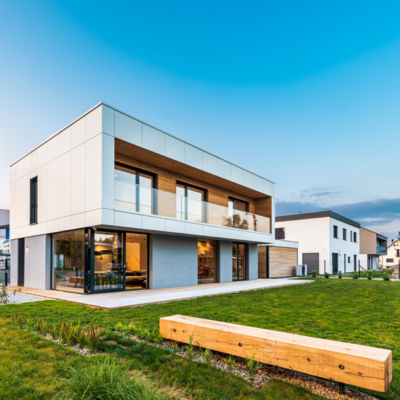Garden Circle House

Comfort:
This newly built 300 m2 single family residence is organized around a central open stair and light/air shaft connecting the three levels of the house (basement to second floor). The ground floor is an open plan while the second-floor rooms are grouped around a central hall, filled with daylight and open to below. In the center of the hall is the horseshoe-shaped stair which is topped with operable skylights and functions as a lightwell, drawing natural light into the center of the house. The operable skylights also create an incredible stack effect for passive cooling and superior natural ventilation in the summer. East- and west-facing windows on the lower level, sheltered by multiple green-roof topped overhangs, bring in cool air that is circulated. There are no windows on the south elevation avoiding unnecessary heat gain in the summer months; however, with ample windows in every room, 100% of the occupied floor area is within 7 meters of an operable window. The infloor radiant heating system combined with high performance insulation, an airtight building envelope and mechanical ventilation with energy recovery reduces heating and cooling needs and dramatically increases comfort levels in the house. Biophilic design strategies have been utilized throughout the house to increase the occupants’ connectivity to the natural environment and improve their well-being.

Energy:
The house’s mechanical and electrical systems are completely integrated with passive design strategies to achieve the most efficient methods of heating, cooling and lighting while minimizing energy costs. Natural ventilation through operable windows reduces demand for air-conditioning, which can be provided by a highly efficient ‘high velocity’ system when required. Strategically oriented windows allow for solar gain in the colder months; complementing the infloor radiant heating system which provides an even level of heating throughout. The multiple green roofs reduce rainwater runoff and promote natural cooling through the plant materials adjacent to windows and the highly insulated walls (R30) help to reduce heat loss and gain through the building envelope. Photovoltaic panels on the roof are planned – rough-in wiring was installed to allow for later installation as well as for a Tesla battery storage system to take advantage of electricity at lower cost time periods and reduce electricity usage from the grid. The integration of these systems results in improved building performance and energy conservation, with an annual energy consumption of only 19.8 KWh/m2 (taken from owner’s utility bills).

Environment:
Emphasis was placed on using environmentally-sustainable materials, with priority given to locally manufactured products. Only FSC-certified lumber and flooring was used and interior wood cabinet products include formaldehyde-free materials. The plumbing runs through PEX tubing made from crosslinked HDPE polymer rather than copper (lighter weight for shipping and less material used in installation). The exterior brick is primarily Brampton Brick, an ISO 14001 certified product whose manufacturing process includes the integration of post-industrial wastes. The limestone used on paths and the porch is a locally-quarried product. A blend of Western red cedar board and Massaranduba offer more longevity where required. Domestic hot water is supplied ‘on demand’ from the combi-boiler (radiant heating system boiler), reducing potable water wastage due to wait times for hot water. All plumbing fixtures included in the house are low flow fixtures. In the landscape design, a cistern collects rainwater for irrigation in the back of the yard, in order to reduce potable water consumption for plants.



